|
|
|
| My Favourite Planet > English >
People > Ancient Greek artists> Potters/vase painters I-M |
| MFP People |
Ancient Greek artists – page 9 |
 |
Page 9 of 14 |
 |
|
| |
| Potters / vase painters I - M |
| |
| I L M |
Potters and
vase painters |
I |
|
|
| |
Iliupersis Painter
Red-figure vase painter in Apulia, Magna Graecia (south Italy), active around 375-350 BC.
One of the pioneers of the middle phase of Apulian vase painting and the "Ornate Style" (also known as the "Rich Style"). Innovations of form and decoration during this phase included: the introduction of elaborate funerary scenes (naiskos vases); fluting (rippling) of lower sections of vessels; extra colours, particularly white and yellow, as well as red and brown; the motif of a female head rising from a flower between tendrils (usually on the necks of vessels); and moulded and painted medallions on the volutes of volute kraters, featuring figures or heads (mascaroons). The Iliupersis Painter has been credited by some scholars with the development of these innovations, which caught on rapidly and are found on an enormous number of south Italian vases from the mid 4th century BC. Around 1,200 surviving red-figured vessels from southern Italian, for example, depict a deceased person in a naiskos (ναΐσκος, diminutive of ναός, temple). See an Apulian red-figure volute krater in Milan on the Medusa page.
He is associated with a number of other contemporary vase painters, including the Painter of Athens 1714, who may have been employed in the same workshop.
Thought to have taught the Lycurgus Painter.
More than 100 paintings on a wide variety of vase types, including 14 volute kraters, have been attributed to the Iliupersis Painter. He painted mythological, bridal, funerary and dramatic scenes featuring several figures on two or more registers (levels) on the necks and bodies of vessels.
He was named by Arthur Dale Trendall (1909-1995), who called him "an artist of the highest importance ", after an Apulian red-figure volute krater depicting the Ilioupersis (Ἰλίου πέρσις, Iliou persis, Sack of Ilium, usually referred to as the Sack of Troy). Around 370-350 BC. From Basilicata (ancient Lucania, Λευκανία, Leukania), Italy. British Museum. Inv. No. 1867,0508.1333 (Vase F 160).
See: www.britishmuseum.org ...
Another well-known vase painting attributed to him is on a volute krater, 370-350 BC, with a depiction Persephone and Plouton in a quadriga, accompanied by Hekate and Hermes. British Museum. Inv. No. 1885,0314.1 (Vase F 277, not on display).
See: www.britishmuseum.org ...
One of his less elaborate works is a red-figure skyphos (cup) with a depiction of a fight between a gryphon and an Arimaspian (see photo below). 380-360 BC. Side B shows a gryphon attacking a horse. Greek section, Civic Archaeological Museum, Milan. Inv. No. A 2000.01.03. |
|
|
| |

An Apulian red-figure skyphos (cup) with a depiction
of a fight between a gryphon and an Arimaspian.
380-360 BC. Attributed to the Iliupersis Painter.
Side B shows a gryphon attacking a horse.
Greek section, Civic Archaeological Museum, Milan. Inv. No. A 2000.01.03.
|
| The Arimaspians (Αριμασποί, Arimaspoi) were a legendary or mythical tribe of one-eyed people, said to have lived in northern Scythia, who fought the gryphons (or griffins) for the gold that they guarded. The earliest mention of them is by Herodotus (Histories, Book 3, chapter 116; Book 4, chapters 13 and 27), who reported that they featured in a poem by Aristeas of Proconnesos (Ἀριστέας), thought to have lived in the 7th century BC. The Arimaspians and the now lost poem, known as the Arimaspea (Ἀριμάσπεα), were subsequently mentioned by Aischylos (Prometheus Bound), Strabo, Pliny the Elder and Pausanias. |
|
|
| |
Potters and
vase painters |
L |
|
 |
|
| |

Ancient Greek school scenes on the outside of an Attic red-figure
kylix (drinking cup), attributed to the Painter of London D12.
465-455 BC. Provenance unknown.
On Side A (top), a grammatistes (teacher) gives his seated pupil a diptychon (writing
tablet) for writing exercises. On Side B a music teacher with a lyre and his pupil.
National Archaeological Museum, Athens. Inv. No. A12462. |
| |
Lycurgus Painter
Red-figure vase painter in Apulia, Magna Graecia (south Italy), active around 360-340 BC.
One of the leading painters of the second phase of the "Ornate Style" of south Italian red-figure vase painting.
Thought to have been a pupil of the Iliupersis Painter.
Paintings on several vases and fragments, mostly large vessels, have been attributed to the Lycurgus Painter. He painted mythological scenes featuring several figures, often in mannered poses and with dramatic facial expressions, and including illusions of perspective and spacial depth.
He was named by Arthur Dale Trendall after an Apulian red-figure calyx krater depicting King Lycurgus (Λυκοῦργος) of Thrace, driven mad by Dionysus, attacking his wife. Around 350-340 BC. From Ruvo di Puglia (Bari), southern Italy. British Museum. Inv. No. GR 1849.6-23.48 (Vase F 271).
The "Parthenopaios krater", an Apulian red-figure calyx krater, is also attributed to the Lycurgus Painter. Civic Archaeological Museum, Milan. Inv. No. A 0.9.1872 (St. 6873). |
|
|
| |
Lydos
Λυδός (the Lydian), perhaps a nickname
Black-figure vase painter in Athens, active around 560-540 BC.
Leader of the "Lydos Group".
Thought to have been a migrant or son of migrants from Lydia in Anatolia (Asia Minor), who learned his trade in Athens.
Along with the Amasis Painter and Exekias, considered as one of the most important and influentual Attic black-figure artists.
See also Lydos the slave below.
Lydos signed two black-figure vases as "hό Λυδός" (ho Lydos, the Lydian):
Fragments of a dinos depicting a Gigantomachy, found on the Athens Acropolis. Surviving parts of figures and inscribed names include Aphrodite, Artemis, Dionysus, Hephaistos, Herakles, Hermes and a Giant. Two incised signatures on a fragment of the rim are thought to refer to Lydos as painter and potter: [hο δεινα εποιε]σεν [:] hο Λυδος : ε[γ]ραφ̣σ̣[εν] ([ho deina epoi]sen ho Lydos e[g]raphs[en]). National Archaeological Museum, Athens. Inv. No. Acr. 1.607.
Beazley Archive Database, Vase No. 310147
A fragmentary B-type amphora in the Louvre, depicting the Ilioupersis (the Sack of Troy) and the death of Priam. In his raised right hand the Greek hero Neoptolemos swings the young Trojan prince Astyanax by his ankle (see Homer part 2). Between the right side of Neoptolemos' body and his shield Lydos' signature is written vertically: hο Λυδος : εγρ[αφ]σεν (ho Lydos : egr[aps]sen). The fragments of Side B show Herakles, probably fighting Kyknos. Thought to be one of Lydos' early works, around 560 BC. Height 27 cm, diameter 25 cm. Louvre. Inv. No. F 29. Purchased from the Campana Collection in 1861.
Beazley Archive Database, Vase No. 310167
See also: cartelfr.louvre.fr/cartelfr/...
Identification of paintings by Lydos has proved difficult since works possibly by him, although similar in style, vary considerably in quality, and due to the fact that he is thought to have been prolific and to have had a long career. Around 100 vessels of various shapes and sizes, including kraters, hydriai, amphorae, loutrophoroi, plates, cups (Siana cups, band cups), a "trick jug" and a psykter-amphora as well as funerary pinakes (plaques), have been securely attributed to Lydos. The attribution of another 74 works is less certain, and may have been made by painters in his workshop, the "Lydos Group", or imitators. Some of these are referred to as being in the "manner" or "style" of Lydos.
Attributed works include:
A large column krater painted right around the body with a lively but dignified depiction of the return of Hephaistos to Olympus (see Hephaistos), accompanied by Dionysus, in a procession with Maenads and Satyrs. Circa 550 BC. Height 56.4 cm, width 69.3 cm, diameter 58.6 cm. Metropolitan Museum, New York. Inv. No. 31.11.11.
See: metmuseum.org/art/collection/search/253349
A double-walled psykter-amphora (wine cooler) showing Theseus and the Minotaur (see photo below) on one side, and Dionysus with satyrs and a maenad on the other. Height 32 cm. British Museum. Inv. No. GR 1848,0619.5 (Vase B 148).
An Attic black-figure krater from Thermi, Macedonia showing the Kalydonian Boar hunt (see photo below). Thessaloniki Archaeological Museum. Inv. No. Θε 546.
Fragments of a band cup from Italy, signed by Nikosthenes as potter, depicting wrestlers. Ashmolean Museum, Oxford. Inv. No. 1966.768.
A belly amphora from Vulci, with depictions of Menelaos recovering Helen to the left, and the death of Priam to the right. State Museums Berlin (SMB). Inv. No. F 1685.
An oinochoe signed by Kolchos as potter. On the body Herakles, supported by Athena, fights Ares over Kyknos, with Zeus intervening. From Vulci. Height 25.5 cm. State Museums Berlin (SMB). Inv. No. F 1732.
A plate with a large bearded Gorgoneion filling the centre. Diameter 24 cm. Staatliche Antikensammlungen, Munich. Inv. No. 8760.
In the Kerameikos Archaeological Museum, Athens (see photos below): fragments of a black-figure plate with a depiction of mourning males, Inv. No. 1909; fragments of a black-figure bowl with a depiction of mourning males; fragments of a black-figure vessel with a depiction of an Amazonomachy.
In the National Archaeological Museum, Athens: a black-figure plate with a painting of Achilles putting on the armour made for him by Hephaistos, in the presence of his mother Thetis, his father Peleus and his son Neoptolemos. All their names are inscribed. Inv. No. 507 (see Homer part 2). |
|
|
| |
Lydos "the slave"
Λυδός δο̃λος
Black-figure vase painter in Athens, active around 550-500 BC.
Thought to be from Myrina, Aeolia, western Anatolia (Asia Minor, today Turkey).
The signature on an inscribed Attic black-figure kyathos, dated to around 550-500 BC, is unclear, but has been read as Λυδὸς ἔγραφσεν δολοσ ον μυδεασσ ευγε[...]ο (Lydos painted it, slave from Myrina), and is thought not to be by the better-known Lydos above. The painting of an assembly of eleven Olympian gods (some names inscribed) with Herakles is in a different style ("late weak style") to other paintings attributed to Lydos. From Tomb 145, Osteria necropolis, Vulci, Etruria (Lazio, Italy). National Etruscan Museum, Villa Giulia, Rome. Inv. No. 84,466.
Beazley Archive Database, Vase No. 6247. |
|
|
| |
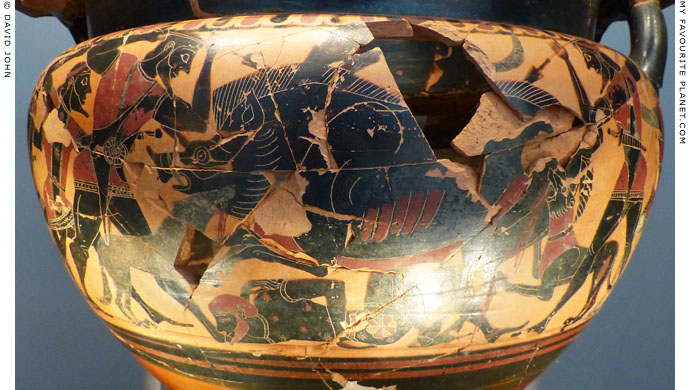
Detail of an Attic black-figure column krater with a depiction of the Kalydonian Boar hunt. Artemis
sent the boar to ravage the countryside of Kalydonia in Aetolia (central Greece), to punish the
Kalydonian king Oeneus (Οἰνεύς) for forgetting to sacrifice to her. Here the boar in the centre
is already wounded, attacked by five hunters with bow and spears, and three dogs. A sixth
huntsman lies, presumably dead, beneath the beast. According to literary sources, the hunting
party consisted of a number of well-known ancient heroes, including Meleagros, Oeneus' son,
the huntress Atalanta and Peleus, father of Achilles.
Attributed to Lydos, around 550 BC. Used as a funerary urn, it contained the ashes of
the deceased person and a Corinthian aryballos. Excavated at the cemetery in Thermi
(today Sedes), Thessaloniki, Macedonia, Greece.
Side B shows an aquatic bird between two facing boars. Beneath each handle is
a flying eagle with outspread wings. On top of each handle a small horizontal,
four-sided plaque with a painted head of a bearded male in profile.
Thessaloniki Archaeological Museum. Inv. No. ΘΕ 546. |
| |
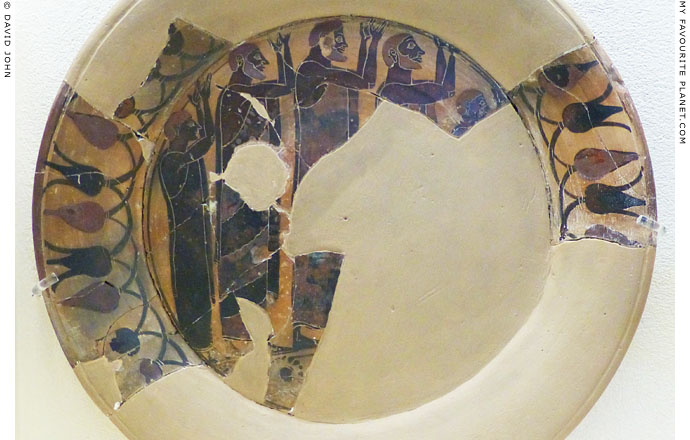
Fragments of an Athenian black-figure plate with
a depiction of draped youths and men mourning.
From the Kerameikos, Athens. Attributed to Lydos, around 575-525 BC.
Kerameikos Archaeological Museum. Inv. No. 1909. |
| |
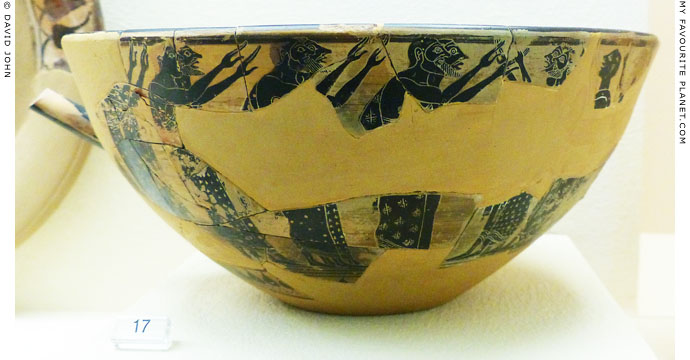
Reconstructed fragments of an Athenian black-figure lekanis (bowl)
with a depiction of two groups of male mourners facing each other.
From the Kerameikos (T HTR 3/VII), Athens.
Attributed to Lydos, around 550 BC.
Kerameikos Archaeological Museum. Inv. No. 1687. |
| |

Fragments of an Athenian black-figure vessel, perhaps a cauldron,
with a depiction of an Amazonomachy, featuring Herakles (left).
From the Kerameikos, Athens. Attributed to Lydos, around 550 BC.
Kerameikos Archaeological Museum. |
| |
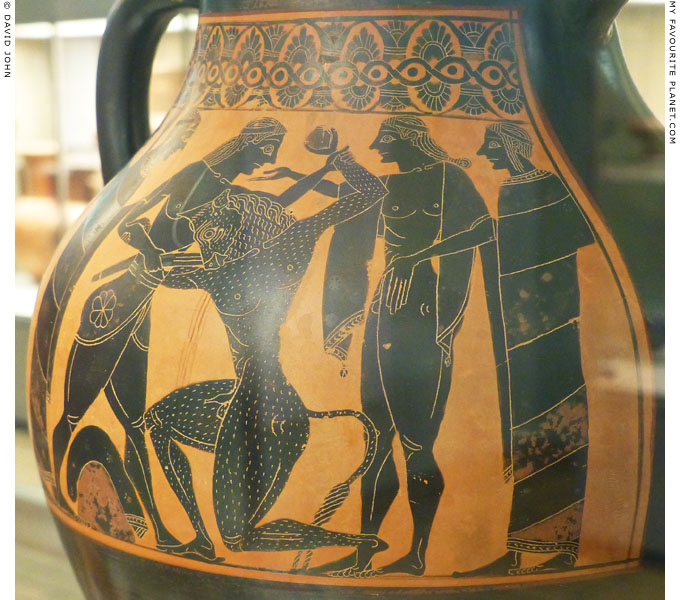
Detail of an Attic black-figure psykter-amphora (wine cooler) with a depiction
of Theseus killing the Minotaur with a sword, watched by young men.
Made in Athens about 560-540 BC. Attributed to the painter Lydos.
The vessel has double walls between which cold water was poured to keep
the wine cool. The other side shows Dionysus with satyrs and a maenad.
Height: 32 cm, width: 23 cm, weight: 2 kg.
British Museum. Inv. No. GR 1848,0619.5 (Vase B 148). Acquired in 1848. |
| |
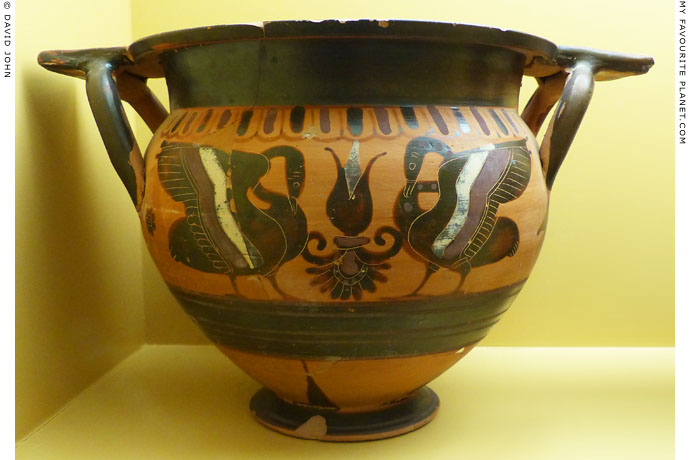
An Attic black-figure column-krater with a painting of two swans standing either side
of a lotus blossom. On Side B is a goat. In the manner of Lydos. Circa 550 BC.
Agora Museum, Athens. |
| |
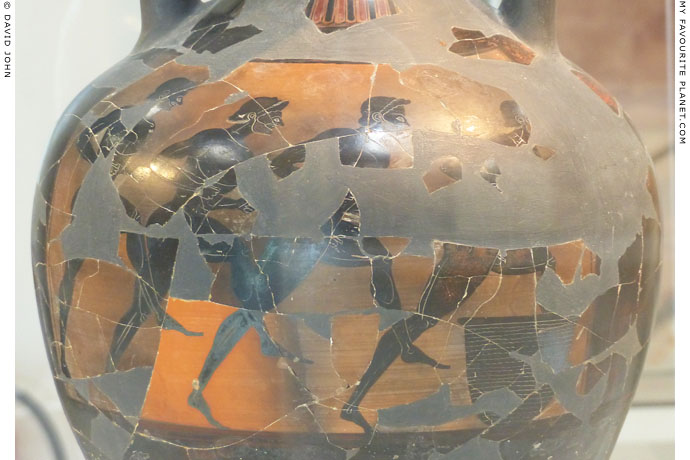
Detail of a restored black-figure Panathenaic amphora showing four runners
in a race. On the right stands a large vessel, perhaps for water.
Made in Athens, late 6th century BC. Painting attributed to the Leagros Group.
Found in the North Temenos Terrace of the Temple of Poseidon at Isthmia,
Corinthia. The amphora was burnt during the fire in the temple.
Side A shows armed Athena striding to the left, and on each side a cockerel on
a tall column. The dedication ΔΑΜΟΝ ΑΝΕΘΕΚΕ is incised below the image panel.
Isthmia Archaeological Museum. Inv. No. IP 1172. |
| |
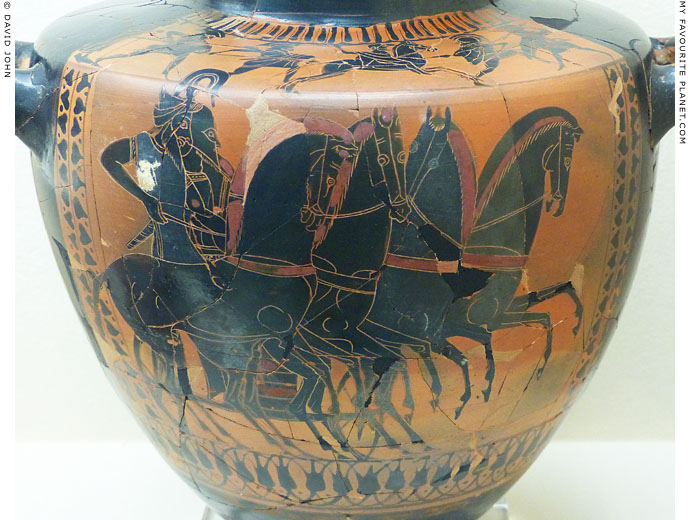
Detail of a resored Athenian black-figure hydria. On the body a
depiction of a charioteer and an armed warrior on a four-horse chariot.
On the shoulder a battle scene with hoplites and a horseman.
Attributed to the workshop of the Lysippides Painter, around 530-520 BC.
Found in several fragments in Offering Pit T hS 183, Kerameikos, Athens.
Kerameikos Archaeological Museum. |
| |
Potters and
vase painters |
M |
|
 |
|
| |
Marsyas Painter
Vase painter in Attica, around 370-330 BC.
The Marsyas Painter is considered the best vase painter of the 4th century BC, particularly for the quality of his drawing and three-quarter views of figures. He is a key artist of the Kerch style, the last phase of Attic red-figure painting around 375-320 BC BC, named after Kerch (ancient Pantikapaion, Παντικάπαιον) on the east coast of the Crimea, where many examples of Kerch ware have been found. Around 12 vessels painted by him have survived, some fragmentary, and recently ten Panathenaic amphorae from Eretria, Euboea have also attributed to him by Greek archaeologist Panos D. Valavanis (Πάνος Δ. Βαλαβάνης).
He was named by John Beazley, following the Swiss archaeologist Karl Schefold (1905-1999) who first collected his works, after a pelike with a depiction of the music contest between Apollo and Marsyas, excavated at Kerch. On Side B is a scene of women bathing and dressing. Hermitage State Museum, Saint Petersburg. Inv. No. St 1795.
Beazley Archive Database, Vase No. 230421
The style of the Marsyas Painter is so similar to that of the Eleusinian Painter, that some scholars believe that the latter was a late stage of the former, rather than a separate person.
Peleus seizing Thetis by the Marsyas Painter, on an Attic red-figure pelike, about 350-340 BC. Found in Kameiros, Rhodes. On Side B: beardless Dionysus seated between a Satyr and a Maenad. British Museum. Inv. No. 1862,0530.1 (Vase E 424).
Another depiction of Peleus capturing Thetis on an Attic red-figure pelike, painted by The Painter of Athens 1472, is so similar in composition that it is thought the two artists worked together in the same wokshop. Toledo Museum of Art, Ohio, Inv. No. 1993.49.
See: Sue Allen Hoyt, Masters, pupils and multiple images in Greek red-figure vase painting. Dissertation, Ohio State University, 2006. At OhioLink, Ohio Department of Higher Education. |
|
|
| |
Micali Painter
Etruscan vase painter working at Vulci, Etruria, late 6th century BC.
An Etruscan black-figure neck amphora ("Round dance") by the Micali Painter, about 525-500 BC. Altes Museum, Berlin. Inv. No. V.I. 3226.
An Etruscan black-figure hydria with a depiction of a Harpy on the body, 530-500 BC, may have been painted by the Micali Painter. Altes Museum, Berlin. Inv. No. F 2157. |
|
|
| |
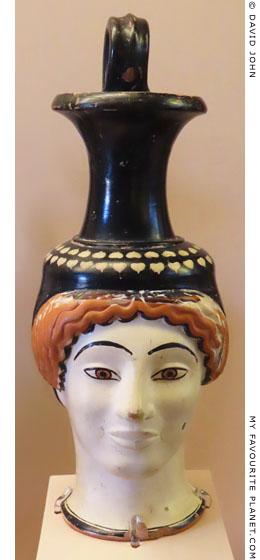
An Attic red-figure oinochoe (οἰνοχόη,
wine jug) in the form of a female head.
Around 525-475 BC. Inscribed in white
paint on the handle (not visible in photo)
is the signature of the potter Midas:
ο Μιδας εποιεσεν
Midas made me
From an inhumation burial of a woman,
Macri Langoni Tomb 30 (84). 475-450 BC.
Found in 1930 during excavations in the
ancient cemetery at Macri Langoni, near
Kamiros, western Rhodes. Height 26 cm,
diameter 6.5 cm.
Rhodes Archaeological Museum.
Inv. No. 12913. |
|
|
|
|
| |
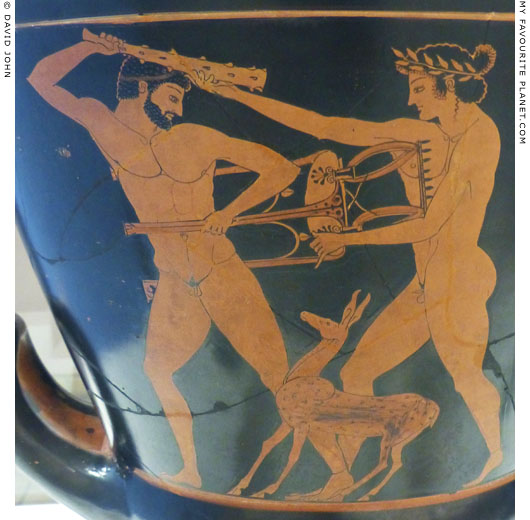
Herakles and Apollo (with a deer) fighting over the Delphic tripod.
Detail of an Attic red-figure calyx krater (wine mixing bowl), made
in Athens around 500-490 BC. Attributed to Myson as painter.
British Museum. GR 1842.8-22.1 (Vase E 458). |
| Photos and articles © David John, except where otherwise specified. |
 |
Visit the My Favourite Planet Group on Facebook.
Join the group, write a message or comment,
post photos and videos, start a discussion... |
|
|
| |
|
|
| |
| |
 |
| |
 |
| |
 |
| |
 |
| |
 |
| |
 |
| |
George Alvanos
rooms in
Kavala's historic Panagia District
Anthemiou 35,
Kavala, Greece
kavalarooms.gr
|
| |
Olive Garden Restaurant
Kastellorizo,
Greece
+30 22460 49 109
kastellorizo.de
|
| |
Papoutsis
Travel Agency
Kastellorizo,
Greece
+30 22460 49 286
greeklodgings.gr
|
| |
|